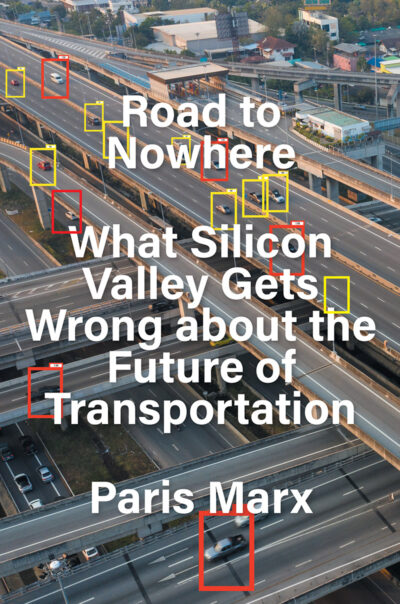a review of Paris Marx, Road to Nowhere: What Silicon Valley Gets Wrong about the Future of Transportation (Verso, 2022)
by Zachary Loeb
You can learn a lot about your society’s relationship to technology by looking at its streets. Are the roads filled with personal automobiles or trolley-cars, bike lanes or occupied parking spaces, are there navigable sidewalks or is this the sort of place where a car is a requirement, does a subway rumble beneath the street or is the only sound the honking of cars stuck in traffic, are the people standing on the corner waiting for the bus or for the car they just booked through an app, or is it some kind of strange combination of many of these things simultaneously? The roadways we traverse on a regular basis can come to seem quite banal in their familiarity, yet they capture a complex tale of past decisions, current priorities, as well as a range of competing visions of the future.
Our streets not only provide us with a literal path by which to get where we are going, they also represent an essential space in which debates about where we are going as a society play out. All of which is to say, as we hurtle down the road towards the future, it is important to pay attention to the fight for control of the steering wheel, and it’s worth paying attention to the sort of vehicle in which we find ourselves.
In Road to Nowhere: What Silicon Valley Gets Wrong about the Future of Transportation, Paris Marx analyzes the social forces that have been responsible for making our roads (and by extension our cities, towns, and suburbs) function the way they do, while providing particular emphasis on the groups and individuals trying to determine what the roads of the future will look like. It is a cutting assessment that examines the ways in which tech companies are seeking to take over the streets, and sidewalks, as well as the space above and below them: with gig-economy drivers, self-driving cars, new tunnels, delivery robots, and much else. To the extent that technological solutions are frequently touted as the only possible response to complex social/political/economic problems, Marx moves beyond the flashy headlines to consider what those technological solutions actually look like when the proverbial rubber hits the road. In Road to Nowhere the streets and sidewalks appear as sites of political contestation, and Marx delivers an urgent warning against surrendering those spaces to big tech. After all, as Marx documents, the lords of the information superhighway are leaving plenty of flaming debris along the literal highways.
The primary focus of Road to Nowhere is on the particular vision of mobility being put forth by contemporary tech companies, but Marx takes care to explore the industries and interests that had been enforcing their view of mobility long before anyone had ever held a smartphone. As Marx explains, the street and the city were not always the possession of the personal automobile, indeed the automobile was at one time “the dominant technology that ‘disrupted’ our society” (10). The introduction of the automobile saw these vehicles careening down streets that were once shared by many other groups, and as automobiles left destruction in their wake, the push for safety was one that was won by ostensibly protecting pedestrians by handing the streets over to the automobile. Marx connects the rise of the personal automobile to “a much longer trend of elites remaking the city to serve their interests” (11), and emphasizes how policies favoring automobiles undermined other ways of moving about cities (including walking and streetcars). As the personal automobile grew in popularity, and mass production made it a product available not only to the wealthy, physical spaces were further transformed such that an automobile became less and less of a luxury and more and more of a need. From the interstate highway system to the growth of suburbs to under-investment in public transit to the development of a popular mythos connecting the car to freedom—Marx argues that the auto-oriented society is not the inevitable result flowing from the introduction of the automobile, but the result of policies and priorities that gradually remade streets and cities in the automobile’s image.
Even as the automobile established its dominance in the mid-twentieth century, a new sort of technology began to appear that promised (and threatened) to further remake society: the computer. Pivoting for a moment away from the automobile, Marx considers the ideological foundations of many tech companies, with their blend of techno-utopian hopefulness and anti-government sentiment wherein “faith was also put in technology itself as the means to address social and economic challenges” (44). While the mythology of Silicon Valley often lauds the rebellious geek, hacking away in a garage, Marx highlights the ways in which Silicon Valley (and the computing industry more generally) owes its early success to a massive influx of government money. Cold War military funding was very good—indeed, essential—for the nascent computing sector. Despite the significance of government backing, Silicon Valley became a hotbed for an ideology that sneered at democratic institutions while elevating the computer (and its advocates) as the bringer(s) of societal change. Thus, the very existence of complex social/political/economic problems became evidence of the failures of democracy and proof of the need for high-tech solutions—this was not only an ahistorical and narrow worldview, but one wherein a group of mostly-wealthy, mostly-white, mostly-cis-male tech lovers saw themselves as the saviors society had been waiting for. And while this worldview was reified in various gadgets, apps, and platforms “as tech companies seek to extend their footprint into the physical world” this same ideology—alongside an agenda that places “growth, profits, and power ahead of the common good”—is what undergirds Silicon Valley’s mobility project (62).
One of the challenges in wrestling with tech companies’ visions is to not be swept away by the shiny high-tech vision of the future they disseminate. And one area where this can be particularly difficult is when it comes to electric cars. After all, amongst the climate conscious, the electric car appears as an essential solution in the fight against climate change. Yet, beyond the fact that “electric vehicles are not a new invention” (64), the electric car appears as an almost perfect example of the ways in which tech companies attempt to advance a seemingly progressive vision of the future while further entrenching the status quo. Much of the green messaging around electric vehicles “narrowly focuses on tailpipe emissions, ignoring the harms that pervades the supply chain and the unsustainable nature of auto-oriented development” (71). Too often the electric car appears as a way for individuals of means to feel that they are doing their part to “personal responsibility” their way out of climate change, even as the continued focus on the personal automobile blocks the transition towards public transit that is needed. Furthermore, the shift towards electric vehicles does not end destructive extraction, it just shifts the extraction from fossil fuels to minerals like copper, nickel, cobalt, lithium, and coltan. The electric car risks being a way of preserving auto-centric society, and this “does not solve how the existing transportation system fuels the climate crisis and the destruction of local environments all around the world” (88).
If personal ownership of a car is such a problem, perhaps the solution is to simply have an app on your phone that lets you summon a vehicle (complete with a driver) when you need one, right? Not so fast. Companies like Uber sold themselves to the public on a promise of making cars available when needed, especially for urban dwellers who did not necessarily have a car of their own. The pitch was one of increased mobility, where those in need of a ride could easily hire one, while cash-strapped car owners could have a new opportunity to earn a few extra bucks driving in the evenings. Far from solving congestion, empowering drivers, and increasing everyone’s mobility, “the Uber model adds vehicles to the road and creates more traffic, especially since the app incentivizes drivers to be active during peak times when traffic is already backed up” (99). Despite claims that their app based services would solve a host of issues, Uber (and its ilk) have added to urban congestion, failed to provide their drivers with a stable income, and have not truly increased the mobility options for underserved communities.
If gig-drivers wind up being such an issue, why not try to construct a world where drivers are not necessary? And thus, perhaps few ideas related to the future of mobility have as firm a grasp on the popular imagination as the idea of the self-driving car. A fantasy that seems straight out of science fiction. Albeit, with good reason. After all, what a science fiction writer can dream up, and what a special effects team can mock up for a movie, face serious obstacles in the real world. The story of tech companies and autonomous vehicles is one of grandiose hype (that often generates numerous glowing headlines), followed by significantly diminished plans once the challenges of introducing self-driving cars are recognized. While much of the infrastructure we encounter is built with automobiles in mind, autonomous cars require a variety of other sorts of not-currently existing infrastructure. Just as “automobiles required a social reconstruction in addition to a physical reconstruction, so too will autonomous vehicles” (125), and this will entail transforming infrastructure and habits that have been built up over decades. Attempts to introduce autonomous vehicles have revealed the clash between the tech company vision of the world and the complexities of the actually existing world—which is a major reason why many tech companies are quietly backing away from the exuberance with which they once hyped autonomous cars.
Well, if the already existing roads are such a challenge, why not think abstractly? Instead of looking at the road, look above the road and below the road! Thus, plans such as Boring’s proposed tunnels, and ideas about “flying cars,” seek to get around many of the challenges the tech industry is encountering in the streets by attempting to capitalize on seemingly unused space. At first glance, such ideas may seem like clear examples of the sort of “out of the box thinking” for which tech companies are famed, yet “the span of time between the initial bold claims of prominent tech figures and the general realization that they are fraudulent appears to be shrinking” (159). And once more, in contrast to the original framing that seeks to treat new tunnels and flying cars as emancipatory routes, what becomes clear is that these are just another area in which wealthy tech elites are fantasizing about ways of avoiding getting stuck in traffic with the hoi polloi.
Much of the history of the automobile that Marx recounts, involves pedestrians being deprived of more and more space, and this is a story that continues as new battles for the sidewalk intensify. As with other tech company interventions in mobility, micromobility solutions that cover sidewalks in scooters and bikes that are rentable via app, present themselves with a veneer of green accessibility. Yet littering cities with cheap bikes and scooters that wear out quickly while clogging the sidewalks, turn out to be just another service “designed to benefit the company” without genuinely assessing the mobility needs of particular communities (166). Besides, all of those sidewalk scooters are also finding that they need to compete for space with swarms of delivery robots that make sidewalks more difficult to use.
From the electric car to the app summoned chauffeur to the autonomous car to the flying car, tech companies have no shortage of high-tech ideas for the future of mobility. And yet, “the truth is that when we look at the world that is actually being created by the tech industry’s interventions, we find that the bold promises are in fact a cover for a society that is both more unequal and one where that inequality is even more fundamentally built into the infrastructure and services we interact with every single day” (185). While the built environment is filled with genuine mobility issues, the solutions put forward by tech companies ignore the complexity of how these issues came about in favor of techno-fixes designed to favor tech companies’ bottom lines while simultaneously feeding them new data streams to capitalize. The gleaming city envisioned by tech elites and their companies may be broadcast to all, but these cities are playgrounds for the wealthy tech elite, not for the rest of us.
The hope that tech companies will come along and sort everything out with some sort of nifty high-tech program speaks to a lack of faith in societies’ ability to tackle the complex issues they face. Yet, to make mobility work for everyone, what is essential is not to flee from politics, but to truly address politics. The tech companies are working to reshape our streets and cities to better fit their needs, but this demands that people counter by insisting that their streets and cities be made to actually meet people’s needs. Instead of looking to cities with roads clogged with Ubers and sidewalks blocked by broken scooters, we need to be paying attention to the cities that have devoted resources (and space) to pedestrians while improving and expanding public transit. The point is not to reject technology but to reject the tech companies’ narrow definition of what technology is and how it can be used, “we need to utilize technology where it can serve us, while ensuring power remains firmly in the hands of a democratic public” (223).
After all, “better futures are possible, but they will not be delivered through technological advancement alone” (225). We can no longer sit idle in the passenger seat, we need to take the wheel, and the wheels.
***
Contrary to its somewhat playful title, Road to Nowhere lays out a very clear case that Silicon Valley’s vision of the future of mobility is in fact a road to somewhere—the problem is that it’s not a good somewhere. While the excited pronouncements of tech CEOs (and the oft-uncritical coverage of those pronouncements) may evoke images of gleaming high tech utopias, a more critical and grounded assessment of these pipedreams reveals them to be unrealistic fantasies mixed with ideas that are designed to primarily meet the needs of tech CEOs over the genuine mobility needs of most people. As Paris Marx makes clear throughout the chapters of Road to Nowhere, it is essential to stop taking the plans of tech companies at face value and to instead do the discomforting work of facing up to the realities of these plans. The way our streets and cities have been built certainly present a range of very real problems to solve, but in the choice of which problems to address it makes a difference whether the challenges being considered are those facing a minimum-wage worker or a billionaire mogul furious about sitting in traffic. Or, to put it somewhat differently, there are flying cars in the movie Blade Runner, but that does not mean we should attempt to build that world.
Road to Nowhere: Silicon Valley and the Future of Mobility provides a thoughtful analysis and impassioned denunciation of Silicon Valley’s mobility efforts up to this point, and pivots from this consideration of the past and the present to cast doubt on Silicon Valley’s future efforts. Throughout the book, Marx writes with the same punchy eloquence that has made Marx such a lively host of the Tech Won’t Save Us podcast. And while Marx has staked out an important space in the world of contemporary tech critique thanks to that podcast, this book makes it clear that Marx is not only a dynamic interviewer of other critics, but a vital critic in their own right. With its wide-ranging analysis, and clear consideration of the route we find ourselves on unless we change course, Road to Nowhere presents an important read for those concerned with where Silicon Valley is driving us.
The structure of the book provides a clear argument that briskly builds momentum, and even as the chapters focus on certain specific topics they flow seamlessly from one to the next. Having started by providing a quick history of the auto-centric city, and the roots of Silicon Valley’s ideology, Marx’s chapters follow a clear path through mobility issues. If the problem is pollution, why not electric cars? If the problem is individual cars, even electric ones, why not make it easy to summon someone else’s car? If the problem is the treatment of the drivers of those cars, why not cars without drivers? If autonomous vehicles are unrealistic because of already existing infrastructure, why not wholly new infrastructure? If creating wholly new infrastructure (below and above ground) is more difficult than it may seem, what about flooding cities with cheap bikes? Part of what makes Road to Nowhere’s critique of Silicon Valley’s ideas so successful is that Marx does not get bogged down in just one of Silicon Valley’s areas of interest, and instead provides a critique that captures that it is not only a matter of Silicon Valley’s response to this or that problem, but that the issues is the way that Silicon Valley frames problems and envisions solutions. To the extent that the auto-centric world is reflective of a world that was remade in the shape of the automobile, Silicon Valley is currently hard at work attempting to remake the world in its own shape, and as Marx makes clear the needs of Silicon Valley companies and the needs of people trying to get around are not the same.
At the core of Marx’s analysis is a sense that the worldview of Silicon Valley is one that is no longer so easily confined to certain geographical boundaries in California. As the tech companies have been permitted to present themselves as the shiny saviors of society, that ideology has often overwhelmed faith in democratic solutions. Marx notes that “as the neoliberal political system gave up on bold policies in favor of managing a worsening status quo, they left the door open to techno-utopians to fill the void” (5). When people no longer believe that a democratic society can even maintain the bridges and roads, it opens up a space in which tech companies can drive into town and announce an ambitious project to remake the roads. Marx further argues, “too often, governments stand back and allow the tech industry to roll out whatever ideas its executives and engineers can dream up,” this belief if undergirded by a sense that “whatever tech companies want is inevitable…and that neither governments, traditional companies, nor even the public should stand in their way” (178). Part of the danger of this sense of inevitability is that it cedes the future of mobility to the tech companies, robbing the municipalities both of initiative and of the responsibility to meet the mobility needs of the people who live there. Granted, as the many failures Marx documents show, just because a tech company says that it will do something does not necessarily mean that it will be able to do it.
Published by Verso Books and written in a clear comprehensive voice, Road to Nowhere stands as an intervention into broad discussions about the future of mobility, particularly those currently taking place on the political left. Thus, even as many readers are likely to cheer at Marx’s skewering of Musk, it is likely that many of those same readers will chafe at the book’s refusal to treat electric cars as a solution. Sure, it’s one thing to lambast Elon Musk (and by extension Tesla), but to critique electric cars as such? Here Marx makes it very clear that we cannot be taken in by too neat techno-fixes, whether they are touted by a specific company (such as Tesla), or whether they are made about a certain class of technologies (electric cars). As Marx makes clear, all of the minerals in those electric cars come from somewhere, and what’s more the issues that we face (in terms of mobility and environmental ones) are not simply the result of one particular technology (such as the gas-powered car) but the way in which we have built our societies around certain technologies and the infrastructure that those technologies require. Therefore, the matter of mobility is about which questions we are willing to ask, and recognizing that we need to be asking a different set of questions.
Road to Nowhere is at its best when Marx does this work by moving past the particular tech companies to consider the deeper matters of the underlying technologies. Certainly, readers of the book will find plenty of consideration of Tesla and Uber (alongside their famous leaders), but the strength of Road to Nowhere is that the book does not act as though the problem is simply Tesla or Uber. Rather, Marx considers the way in which the problem forces us to think about automobiles themselves, about the long history of automobiles, and about the ways in which so much physical infrastructure has been built to prioritize the use of automobiles. This is, obviously, not to give Uber or Tesla a pass—but Marx does the essential work of emphasizing that this isn’t just about a handful of tech companies and their bombastic CEOs, this is a question about the ways in which societies orient themselves around particular sets of technologies. And Marx’s response is not a call for a return to some romanticized pastoral landscape, but is instead an argument in favor of placing the needs of people above the needs of technologies (and the people selling those technologies). Much of our built environment has been constructed around the automobile, what if we started building that environment around the needs of the human being?
The challenge of what it would mean to construct our cities around the needs of people, rather than the needs of profit (or the needs of machines), is not a new question. And while Marx briefly considers some past figures who have wrestled with this matter—such as Jane Jacobs and Murray Bookchin—it might have been worthwhile to spend a little more time engaging more fully with past critics. At risk of becoming too much of a caricature of myself as a reviewer, it does seem like an unfortunate missed opportunity in a book about technology and cities not to engage with the prominent technological critic Lewis Mumford whose oeuvre includes numerous books specifically on the topic of technology and cities (he won the National Book Award for his volume The City in History). And these matters of cities, speed, and vehicles have been topics with which many other critics of technology engaged in the twentieth century. Indeed, the rise of the auto-centric society has had its critics all along the way, and it could have been fascinating to engage with more of those figures. Marx certainly makes a strong case for the ways in which Silicon Valley’s designs on the city are informed by its particular ideology, but engaging more closely with earlier critics of technology could have opened up other spaces for considering broader problems about ideologies surrounding technology that predate Silicon Valley. Of course, it is unfair to criticize an author for the book they did not write, and the intention is not to take away from Marx’s important book—but contemporary criticism of technology has much to gain not just from the history of technology but from the history of technological criticism.
Road to Nowhere is a challenging book in the best sense of that word, for it discomforts the reader and pushes them to see the world around them in a new light. Marx achieves this particularly well by refusing to be taken in by easy solutions, and by recognizing that even as techno-fixes may be the standard offering from Silicon Valley, that a belief in such fixes permeates beyond just the pitches by tech firms. Nevertheless, Marx is also clear in recognizing that even as many of our problems flow from and have been exacerbated by technology, that technology needs to be seen as part of the solution. And here, Marx is deft at considering the way in which technology represents a much more robust and wide-ranging category than the too simplistic version that it is often reduced to when conversations turn to “tech.” Thus, the matter is nothing so ridiculous as conversations about being “pro-technology” or “anti-technology” but recognizing “that technology is not the primary driver in creating fairer and more equitable cities and transportation systems” what is necessary is “deeper and more fundamental change to give people more power over the decision that are made about their communities” (8). The matter is not just about technology (as such), but about the value systems embedded in particular sorts of technologies, and recognizing that certain sets of technologies are going to be better for achieving particular social goals. After all, “the technologies unleashed by Silicon Valley are not neutral,” (179) though the same is also very much true of the technologies that were unleashed before Silicon Valley. Constructing a different world thus requires us to consider not only how we can remake that world, but how we can remake our technologies. As Marx wonderfully puts it, “when we assume that technology can only develop in one way, we accept the power of the people who control that process, but there is no guarantee that their ideal world is one that truly works for everyone” (179).
You can learn a lot about your society’s relationship to technology by looking at its streets. And Road to Nowhere is a powerful reminder, that those streets do not have to look the way they do, and that we have a role to play in determining what future those streets are taking us towards.
_____
Zachary Loeb earned his MSIS from the University of Texas at Austin, an MA from the Media, Culture, and Communications department at NYU, and is currently a PhD candidate in the History and Sociology of Science department at the University of Pennsylvania. Loeb works at the intersection of the history of technology and disaster studies, and his research focusses on the ways that complex technological systems amplify risk, as well as the history of technological doom-saying. He is working on a dissertation on Y2K. Loeb writes at the blog Librarianshipwreck, and is a frequent contributor to The b2o Review Digital Studies section.









